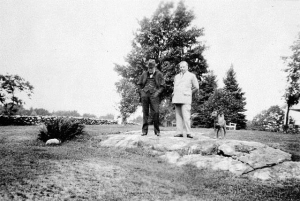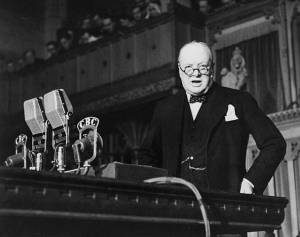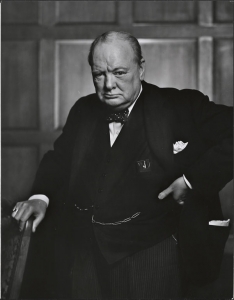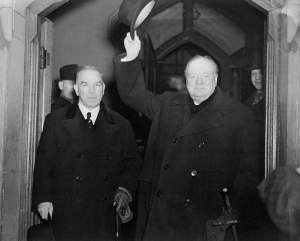Caught on Camera: Winston Churchill in Ottawa | Capturé sur photo: Winston Churchill à Ottawa
By: Delany L

During a trip to the City of Ottawa Archives to collect photographs for our upcoming exhibit, I stumbled upon an album showing the iconic British Prime Minister Winston Churchill visiting the city. I found it quite intriguing to see such a notable figure in front of many familiar landmarks in all of our daily lives. It was a poignant reminder that even though it can seem like historical figures are distant elements of the past, they were once very real people. Since Ottawa is probably the most likely places in Canada to host such visits, we are uniquely fortunate to share our wonderful home with a vast range of visitors past and present.

Upon further investigation, I learned that Churchill actually visited numerous times throughout his life. I was surprised to discover that some of the most iconic moments of his life actually took place in Ottawa, creating a special link between the city and his legacy. The day after Japanese bombers attacked Pearl Harbor on 7 December, 1941, Churchill dismissed security concerns and decided to make the perilous ten-day journey to North America by sea. After arriving in American territorial waters, he penned a letter back home to his wife, Clementine: “I feel I ought to go to Canada while I am over this side, but I do not quite know when or how I shall come back. I shall certainly stay long enough to do all that has to be done, having come all this way that so much trouble and expense.”
After spending time in Washington, he made the journey across the border by train. It was right here in Ottawa that he delivered his famous “some chicken, some neck!” speech on 30 December to a group of Canadian MPs and Senators in the House of Commons:
“When I warned them that Britain would fight on alone whatever they did, their generals told their Prime Minister and his divided Cabinet, ‘In three weeks England will have her neck wrung like a chicken.’ Some chicken! Some neck! The story goes that Prime Minister William Lyon Mackenzie King originally requested that Churchill speak to an audience at the Chateau Laurier, but the latter felt that the House of Commons was “more dignified.”

Since his goal was for the speech’s message to be heard around the world, he felt that the proceedings needed to be both well-attended by the press and captured on film. Fortunately for us, that was the case, and a portion of the speech can be viewed here: https://youtu.be/XyoY6UzWLEo

It was also right here that the defining photograph of Churchill’s life was taken by Ottawa photographer Yousef Karsh. Karsh was chosen by Mackenzie King himself for the task, which the Canadian Prime Minister kept a secret until it was impossible for Churchill to resist the engagement. Shortly after the delivery of his speech and subsequent celebratory glass of scotch, he made his way into the private room in Parliament which Karsh had prepared for the session. The papers seen peeking out from his pocket contain the speech he had delivered mere hours previous, and the scowl on his face is owed to Karsh’s rash removal of the cigar from his mouth. While he already had a growing local following, the image quickly brought Karsh international fame, and it remains the single most iconic photographic portrait in history.
It is amazing to reflect upon just how significant Ottawa is as a historical landmark not just in terms of Canadian history, but in this case of a great British and Allied leader during some of the world’s darkest days. Next time you are making your way down Wellington Street, just remember that your same steps have been taken by many a notable figure both visiting and from right here in Canada. We Ottawans are so lucky to be able to live and work among these famous footsteps!

To read more about Winston Churchill’s Canadian connections, here is a great resource from Winstonchurchill.org: http://www.winstonchurchill.org/publications/finest-hour/finest-hour-154/as-they-saw-him-encounters-with-canadians-1900-1955
Capturé sur photo: Winston Churchill à Ottawa
Par: Delany L

Effectuant une visite aux archives de la Ville d’Ottawa pour recueillir des photos en vue de notre prochaine exposition, je suis tombée sur un album montrant l’emblématique premier ministre britannique Winston Churchill en visite à Ottawa. J’ai été étonnée de voir une personne aussi notoire devant tant de lieux connus qui font partie de notre vie quotidienne. Cela nous rappelle avec force que même si les personnages historiques semblent des figures d’un lointain passé, ils ont été un jour de réelles personnes. Comme Ottawa est le lieu le plus probable du Canada pour de telles visites, nous avons la chance unique d’avoir accueilli, de nos jours et par le passé, un vaste éventail de visiteurs.

Des recherches supplémentaires m’ont appris que Churchill était venu plusieurs fois à Ottawa tout au long de sa vie. J’ai découvert avec surprise qu’il avait passé certains des moments les plus significatifs de sa vie dans notre ville, créant un lien spécial entre Ottawa et l’héritage qu’il nous a légué. Le 7 décembre 1941, au lendemain du bombardement de Pearl Harbor par les Japonais, Churchill, faisant fi des préoccupations en matière de sécurité, décide d’entreprendre par voie maritime un périlleux voyage de dix jours en Amérique du Nord. Une fois arrivé dans les eaux territoriales américaines, il écrit à sa femme Clementine : « Je me sens tenu de me rendre au Canada pendant que je me trouve ici, mais j’ignore quand ni comment je reviendrai. Je resterai certainement assez longtemps pour accomplir tout ce que je dois faire, puisque j’ai parcouru ce long chemin en ne ménageant ni ma peine ni mes dépenses. » Churchill passe du temps à Washington, après quoi il traverse la frontière en train. C’est à Ottawa même qu’il prononce le 30 décembre son célèbre discours « Some chicken! Some neck! » (Quel poulet! Quel cou!) devant un groupe de députés et de sénateurs canadiens à la Chambre des communes :
« Quand je les ai prévenus que la Grande-Bretagne combattrait seule peu importe ce qu’ils feraient, leurs généraux ont déclaré au premier ministre et à son cabinet divisé : “Dans trois semaines, nous aurons tordu le cou à l’Angleterre comme un poulet”. Quel poulet! Quel cou! »

On dit qu’à l’origine, le premier ministre William Lyon Mackenzie King aurait demandé que Churchill parle devant un auditoire réuni au Château Laurier, mais Churchill a considéré que la Chambre des communes était un lieu « plus digne ». Dans la mesure où il voulait que son discours soit entendu dans le monde entier, il a voulu s’assurer la présence de nombreux membres de la presse et capter ce moment sur film. Heureusement pour nous, cet enregistrement a été réalisé, et l’on peut entendre un extrait de son discours à l’adresse suivante : https://youtu.be/XyoY6UzWLEo (en anglais).

C’est aussi dans notre ville que le photographe d’Ottawa Yousuf Karsh a réalisé la photographie qui définit la vie de Churchill. Mackenzie King lui‑même a choisi Karsh pour lui confier cette tâche, et il a gardé le secret jusqu’à ce Churchill ne puisse plus se dédire. Peu après avoir prononcé son célèbre discours et célébré en buvant un verre de scotch, Churchill s’est rendu dans la salle privée du Parlement que Karsh avait préparée pour la séance. Les papiers qui sortent de sa poche contiennent le discours prononcé quelques heures plus tôt, et il a l’air renfrogné parce que Karsh a eu la témérité de lui retirer le cigare des lèvres. Karsh jouissait à l’époque d’une notoriété locale, mais sa photo de Churchill l’a rendu instantanément célèbre dans le monde entier. Cette image demeure encore le portrait photographique unique le plus emblématique de l’histoire.
L’importance d’Ottawa comme emblème historique de l’histoire canadienne ne fait aucun doute, mais on constate aussi le rôle primordial qu’a joué la ville auprès d’un dirigeant britannique et allié durant les jours les plus sombres de l’histoire mondiale. La prochaine fois que vous longerez la rue Wellington, rappelez‑vous que de nombreuses personnalités d’ici et d’ailleurs ont parcouru ce même chemin. Les résidents d’Ottawa ont la chance de vivre et de travailler au milieu de ces empreintes célèbres!

